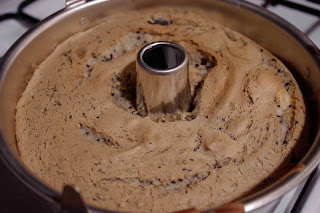Ever since I got Keiko Ishida’s Okashi: sweet treats made with love, I’ve been eyeing off the three chiffon cakes and waiting for a chance. It happened to be Alida Irwin’s 111th birthday recently, and I put together a Japanese meal – I thought she, as a woman of the 1920s, might find a touch of the Orient interesting and exotic, but it turned out she’d already been there twice and had actually done a stint as a Noh entertainer while carving out her illustrious career as an undercover spy. But I digress.
For dessert I decided at the last minute to have a go at Keiko’s black sesame chiffon cake, which looked so majestic, tall and plain, pure white on the outside and porous grey-black inside. It seemed my regular non-stick little-used Bundt tin might do for it; I even had black sesame seeds on hand. And it wasn’t bad, for a first go, and for one with no concept whatsoever about chiffon cakes.
Its strangely elastic yet light texture, which seemed at odds with its 5 eggs, piqued my interest, and I decided to look further into the subject. On Google, I found chiffon cake was, variously, a Malaysian sweet and one invented by a Californian salesman in the 1940s. Either way, a tube tin that wasn’t non-stick or even greased was needed, and ideally would have little feet at the top so it could be inverted to cool the baked cake – eliminating collapse. Various sources claimed chiffon cake tins could be got at any Asian grocery for a song.
I embarked on a quest through the not-inconsiderable number of Asian groceries in my area, spreading out from Brunswick Street to Richmond and Chinatown. No one had ever heard of them. I eventually got the tin at London & American stores, though it was 23 rather than 20cm. And I found it rusted if any water was allowed to be in its vicinity for longer than a few minutes, so it’s one of those things that has to be dried in a warm oven after washing.
Black sesame paste was another challenge, with treks to Minh Phat for items thus labelled yielding a sprinkle-able gray powder before the much more paste-like version was found.
So after all that, I put it together without any fuss, but the hard-won cake tin didn’t yield as good a result as Alida’s. It was rather vertically challenged and sad, though its texture and taste was good. Still, I’ll have another go at the red bean and matcha versions – after all, I spent $28 on another cake tin, and by God it will be put to use.
(adapted from Keiko Ishida)
5 egg yolks
20g brown sugar
30g black sesame paste
60g water (yep, by weight)
40g vegetable oil
20g black toasted sesame seeds
20g brown sugar
30g black sesame paste
60g water (yep, by weight)
40g vegetable oil
20g black toasted sesame seeds
5 egg whites
90g caster sugar
10g rice or corn flour
90g caster sugar
10g rice or corn flour
70g cake flour
250mL cream
20g caster sugar
more black sesame seeds to garnish
Centre a rack in the oven so a tallish tin can fit in, and preheat it to 170C. Sift flour.
Combine egg yolks, brown sugar and black sesame paste in a bowl and mix well. Add water and oil and mix well. Add flour and mix until batter becomes sticky, then fold in black sesame seeds.
For the meringue, combine sugar and corn flour. Beat egg whites until foamy. Gradually add sugar mixture and continue whisking till whites are glossy, with stiff peaks.
Add a third of the meringue into egg yolk mixture and fold lightly before folding in the remainder to just incorporate – you don’t want the weighty yolk mixture to deflate the buoyancy of the whites.Not that you necessarily want the pockets of white that I had, either.
Pour batter into an ungreased chiffon cake tin – I cut out a circle of baking paper to line the bottom, but that was all. Bake for 50 minutes. When cake is light brown on top, remove from the oven and turn it over, leaving it to cool.
Pour batter into an ungreased chiffon cake tin – I cut out a circle of baking paper to line the bottom, but that was all. Bake for 50 minutes. When cake is light brown on top, remove from the oven and turn it over, leaving it to cool.
Whip together the cream and sugar, and ice the cake with a spatula, avoiding crumb spreadage as best you can.
To remove chiffon cake from pan, run a spatula along the sides of the cake to release it.
 |
| The next day, about a third its proper height |




Is that the BEST INTRO EVER? Or is it just me?
ReplyDeleteIt was certainly a cake to behold. And consume. And make again.